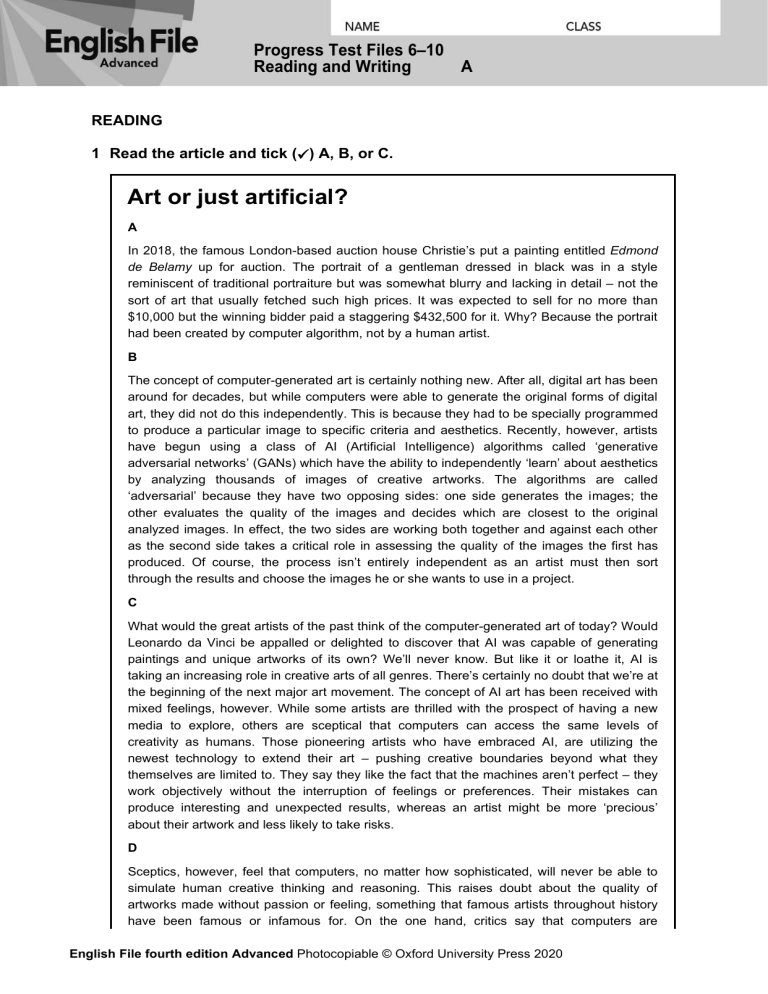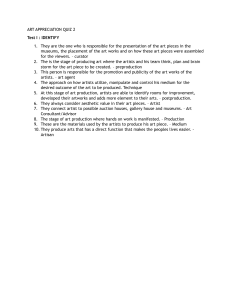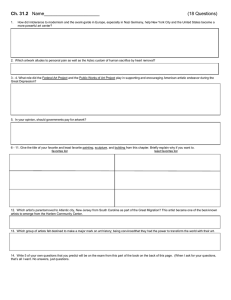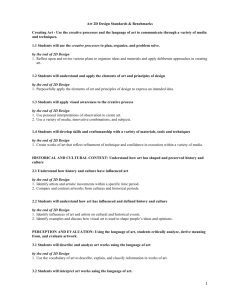
Progress Test Files 6–10 Reading and Writing A READING 1 Read the article and tick (✓) A, B, or C. Art or just artificial? A In 2018, the famous London-based auction house Christie’s put a painting entitled Edmond de Belamy up for auction. The portrait of a gentleman dressed in black was in a style reminiscent of traditional portraiture but was somewhat blurry and lacking in detail – not the sort of art that usually fetched such high prices. It was expected to sell for no more than $10,000 but the winning bidder paid a staggering $432,500 for it. Why? Because the portrait had been created by computer algorithm, not by a human artist. B The concept of computer-generated art is certainly nothing new. After all, digital art has been around for decades, but while computers were able to generate the original forms of digital art, they did not do this independently. This is because they had to be specially programmed to produce a particular image to specific criteria and aesthetics. Recently, however, artists have begun using a class of AI (Artificial Intelligence) algorithms called ‘generative adversarial networks’ (GANs) which have the ability to independently ‘learn’ about aesthetics by analyzing thousands of images of creative artworks. The algorithms are called ‘adversarial’ because they have two opposing sides: one side generates the images; the other evaluates the quality of the images and decides which are closest to the original analyzed images. In effect, the two sides are working both together and against each other as the second side takes a critical role in assessing the quality of the images the first has produced. Of course, the process isn’t entirely independent as an artist must then sort through the results and choose the images he or she wants to use in a project. C What would the great artists of the past think of the computer-generated art of today? Would Leonardo da Vinci be appalled or delighted to discover that AI was capable of generating paintings and unique artworks of its own? We’ll never know. But like it or loathe it, AI is taking an increasing role in creative arts of all genres. There’s certainly no doubt that we’re at the beginning of the next major art movement. The concept of AI art has been received with mixed feelings, however. While some artists are thrilled with the prospect of having a new media to explore, others are sceptical that computers can access the same levels of creativity as humans. Those pioneering artists who have embraced AI, are utilizing the newest technology to extend their art – pushing creative boundaries beyond what they themselves are limited to. They say they like the fact that the machines aren’t perfect – they work objectively without the interruption of feelings or preferences. Their mistakes can produce interesting and unexpected results, whereas an artist might be more ‘precious’ about their artwork and less likely to take risks. D Sceptics, however, feel that computers, no matter how sophisticated, will never be able to simulate human creative thinking and reasoning. This raises doubt about the quality of artworks made without passion or feeling, something that famous artists throughout history have been famous or infamous for. On the one hand, critics say that computers are English File fourth edition Advanced Photocopiable © Oxford University Press 2020 Progress Test Files 6–10 Reading and Writing A machines and will therefore always produce substandard quality work. But on the other hand, art is subjective – everyone will have a different idea of what they like and dislike and we all have the right to our own opinions. E Another issue worth considering is the speed at which AI art can be created in comparison to the many hours, weeks, months, or even years that human artists can spend creating an artwork themselves. Of course, a computer’s complete lack of passion and care about a final artwork can speed up the process considerably, but that raises a serious question in terms of artists’ livelihoods: if the art market becomes flooded with quickly produced AI artworks, will there still be a market for original man-made art in future? F There have also been concerns raised about the legal implications of AI-generated art. If it has been created by a machine, is there actually an artist? In most cases, it is an artist who uses the AI, and chooses the images created by it, but who has true ownership and copyright of the artwork in that case? In addition, many speculate about the value of such artworks, and whether process is in fact more important than the finished piece. These are questions that will be answered over time but it’s unlikely that AI will replace human artists altogether. Just as the work of the great artists of the past was informed by the social and political context of their times, AI, working in collaboration with humans, will eventually find its role in modern society in the future. 1 In section A the writer’s main intention is to ________. A explain the process of selling artworks B criticize computer-generated art C highlight a significant event in the art world 2 Which of the following does the writer describe in section B? A The reasons why AI artwork has become popular. B How AI art is generated. C The origins of digital art. 3 In section B, what do the two sides in the AI art algorithms do? A They work independently of each other and then compare the results. B They work together but in different roles. C They compete against each other to create the best image. 4 What does the writer wonder about ʻthe great artists of the past’ in section C? A Whether they could create artworks of equal quality to computers. B Whether they would use AI in their projects. C Whether they would approve of AI-generated art. 5 Which of the following reasons does the writer give in section C to support AI art? A Some artists feel that AI enhances their creativity rather than work against it. B AI takes a lot of the pressure of competition off artists. C AI art is novel at the moment so it can make the artists who use it more successful. English File fourth edition Advanced Photocopiable © Oxford University Press 2020 Progress Test Files 6–10 Reading and Writing A 6 Which of the aspects of AI technology does the writer say artists appreciate in section C? A It can’t argue with their creative decisions. B It can come up with surprising results. C It can be as creative as humans. 7 According to the writer in section D, sceptics doubt that AI would be able to create quality art because ________. A people relate better to human art B the technology is not yet sophisticated enough C it is unable to feel emotion 8 In section E, the writer points out that ________. A when it comes to art, people’s tastes are very different B AI will eventually have the same level of care in producing artwork as humans C AI can create artworks much faster than human artists 9 In section F, the writer discusses ________. A his own experiences of using AI B issues that might affect the careers and legal rights of artists C the prices AI-generated art could sell for in the future 10 The writer’s main objective in the text is to ________. A compare the creative abilities of AI technology and human artists B criticize artists who use AI in their projects C give an explanation of the current conflicting views on AI-generated art 10 2 In which section of the article (A–F) are the following mentioned? 1 2 3 4 5 the fact that individuals have their own unique views on art __ the benefit of errors in the creative process __ the writer’s predictions for how AI will fit into the art world in future __ the involvement of humans in the AI-generated art process __ a critical evaluation of a work of art __ 5 Reading total English File fourth edition Advanced Photocopiable © Oxford University Press 2020 15






